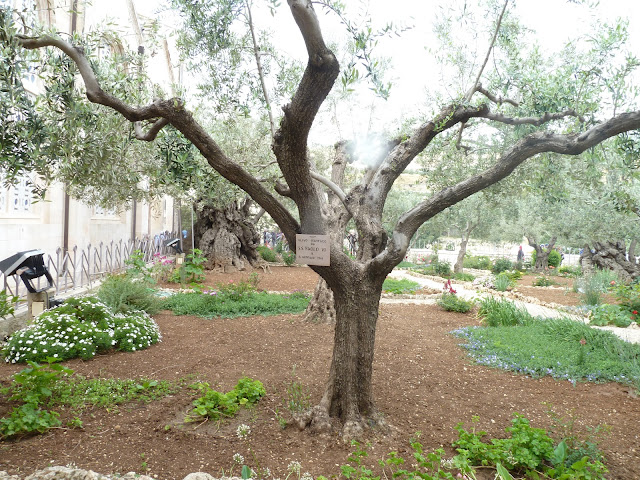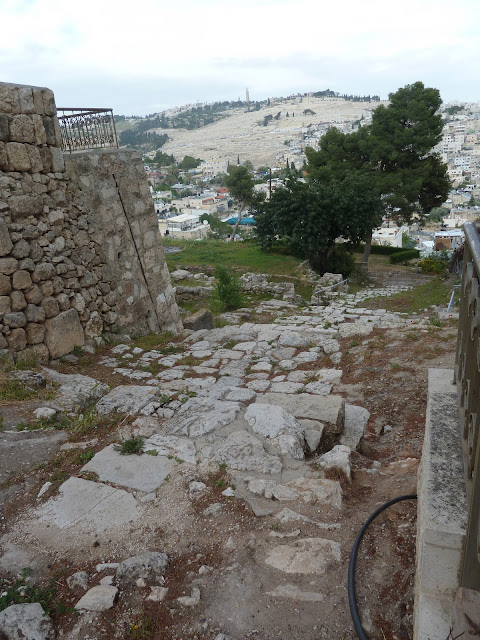Jerusalem
We commenced the day with a visit to sites outside the walls of the Old City...
Church of the Pater Noster
Our next stop... Mount of Olives
The church, on the Mount of Olives, commemorates the site where Jesus taught His disciples the Our Father. The original church was erected in the 4th century by St Helena - she was VERY busy!
The Our Father is recorded in 140 languages around the walls - starting with Aramaic and Hebrew! The Hebrew and Aramaic have the same letters but each letter represents something completely different.
The Our Father is recorded in 140 languages around the walls - starting with Aramaic and Hebrew! The Hebrew and Aramaic have the same letters but each letter represents something completely different.
For our Italian families at Mater Dei
For our Greek families at Mater Dei
Our next stop... Mount of Olives
From the Franciscan church of Dominus Flevit you have a wonderful view across the Kidron Valley to Jerusalem. It was here that we celebrated another memorable Mass. This is believed to be the place where Jesus wept over Jerusalem.
Another beautiful mass in the intimate little church
Palm Sunday carving
Looking across to the Dome of the Rock and the Old City with the
Muslim cemetery against the old City wall - a much photographed scene!
The main Jewish cemetery with over 150,000 tombs
Garden of Gethsemane
At the bottom of the Mount of Olives is the Garden of Gethsemane. This is a beautiful garden with ancient trees that have been here for many centuries, estimated at between one and two thousand years. The original trees were cut down by the Romans in the sacking of the city but it is believed they have regrown from the original root stock. The garden was much larger in the time of Christ and the Church of the Agony, also known as the Church of All Nations or Church of Gethsemane, was built within the original garden.
A young tree - almost 50 years old - planted by Pope Paul VI in 1964.
The Church of All Nations was built between 1919-1924 on the site of a 4th century Byzantine Basilica. The much photographed mosaic facade!
Our next stop was the Old City of Jerusalem...
Statue of David in Jerusalem
The Haredi Jews (the most conservative Orthodox Jews) keep damaging the new statue of David as they want it moved further away from what they revere as the Tomb of David (a fact disputed by others).
Mt Zion Upper Room
It has been traditionally held that the room of the Last Supper was on Mt Zion - outside the city walls.
Although this room was built in the 12th century by the Crusaders there is a belief that it stands over the original site.
Church of the Dormition
According to local tradition it was at this place, near the site of the Last Supper, that the Blessed Virgin Mary was assumed into Heaven or rather fell into an eternal sleep. The original church was built on the site in 383AD and this is the fourth church on the site due to the destruction of the others over the centuries by invaders.
Lunch in Bethlehem
The group returned to Bethlehem for lunch in a Palestinian tent restaurant.
A suspect group of 'so called' Palestinians
The Church of St Peter in Gallicantu (meaning cockcrow- outside the Old City)
This church commemorates the place where Peter denied knowing Jesus three times and is situated within the steep slope of Mt Zion.
Peter's denial is recorded in all four Gospels.This scene was in the courtyard of the High Priest Caiphas. The church is built over the site of a Byzantine church that was believed to have been built on the site of the High Priest's house.
After Jesus was arrested he was taken to the House of Caiphas, the High Priest.
The ancient stairway linked to the time of Jesus contains a rock-cut flagellation post.
The proximity of this prison cell to the House of Caiphas suggests that it was the public gaol. Tradition says that it was the place where Jesus was held overnight before he was crucified and where Peter and John would have been held and scourged for preaching the name of Jesus in the Temple area after the Resurrection. The only entrance to the cell at that time was by a rope harness which meant prisoners were lowered in and out in the dark, with no knowledge of who was or how many were already inside.
I wonder how Jesus felt imprisoned in this cold, dark place?
It was cold and dark. In this place we could feel the spirit of the suffering of Jesus as we listened to the words of the prophet Isaiah foretelling this event.
The denial by Peter
to Gethsemane...
Gethsemane revisited
The large rock in front of the high altar is the 'Rock of Agony' where Jesus prayed in the garden before being arrested. Australia gave the gift of the wrought-iron fencing in the shape of the 'Crown of Thorns' and olive branches.
It was wonderful to be here for this holy hour by ourselves and to pray together...
"Stay here while I go over there to pray"
He took Peter and the two sons of Zebedee with him. And sadness came over him and great distress.
He came back to the disciples and found them sleeping, and he said to Peter, "So you had not the strength to keep awake with me one hour" You should be awake and praying not to be put to the test. The spirit is willing but the flesh is weak." read Matthew 26: 36-56
Then we walked amongst the old trees in the Garden and felt something of the emotion of that night.. I wondered How are we like the disciples? Could we stay awake with Our Lord?
The gnarled trunk of an old olive tree.
Night visit to the Old City
The women's side of the Western Wall - people put prayers in the cracks between the blocks hoping that God will hear their prayers.
A large group of pilgrims decided to continue exploring the Old City - at night.
We entered the gates of the Muslim cemetery built along the wall of the Old City - this was usually closed at night. Some Israeli soldiers followed us in but they were just keeping an eye on us and talked later and had photos taken with a number of the women in our group.
The Muslim cemetery is built in front of the Golden Gate. This is intended to stop the Messiah's entry through this gate when he comes at the end of time.
We entered the gates of the Muslim cemetery built along the wall of the Old City - this was usually closed at night. Some Israeli soldiers followed us in but they were just keeping an eye on us and talked later and had photos taken with a number of the women in our group.
The Muslim cemetery is built in front of the Golden Gate. This is intended to stop the Messiah's entry through this gate when he comes at the end of time.
Deserted streets of the Old City at night.
Shops along the narrow street
Shops - a hive of activity the next day!
The Western Wall ( also known as the Wailing Wall) was not actually part of the Temple but was part of the retaining wall. It was built by King Herod in 20BC. The first two courses are original and there are 7 underground. The Romans destroyed Jerusalem and the Temple in 70AD.
Once a year, in the time of the Second Temple, the High Priest entered the Holy of Holies. He was usually a very old man so they tied a rope to his leg so that if he died while ringing the bells and incensing they could pull him out. The bowing of the Jews at the wall is in memory of the action of the high priest.
The people walk backwards from the wall as a sign of respect.
The women's side of the Western Wall - people put prayers in the cracks between the blocks hoping that God will hear their prayers.
The area in front of the Wall is where a neighbouring Arab district used to exist but this was demolished by the Jews following the six day war in 1967. Orthodox Jews can be seen chanting at the wall and swaying. Some Jews visit daily to recite the Book of the Psalms.



















































No comments:
Post a Comment